The Hertzsprung-Russell diagram reveals essential relationships between stars’ temperature and luminosity. You’ll find hot, bright stars in the upper left and cool, dim stars in the lower right, with most stars falling along the main sequence. Your position on this cosmic map indicates your mass, age, and evolutionary stage—whether you’re a main sequence star like our Sun, an expanding giant, or a cooling white dwarf. The diagram reveals the complete life story of every star in our universe.
The Origin Story: How the H-R Diagram Was Discovered

While many astronomical discoveries stem from a single breakthrough, the Hertzsprung-Russell diagram emerged from parallel research conducted by two astronomers working independently. In 1912, Ejnar Hertzsprung and Henry Norris Russell both discovered the remarkable relationship between stellar temperature and luminosity.
The intertwined legacy of Hertzsprung and Russell exemplifies how scientific revelations often emerge from minds working worlds apart.
Hertzsprung noticed stars with narrow spectral lines had smaller proper motions, indicating greater distance and higher luminosity. Meanwhile, Russell plotted stars’ absolute magnitude against their B-V color index (representing temperature).
When Russell presented his findings, the scientific community immediately recognized its significance. The resulting diagram revealed a smooth curve with distinct groupings, allowing astronomers to classify stars based on their evolutionary stages.
You can now understand why the Hertzsprung-Russell diagram revolutionized our comprehension of stellar evolution, providing a visual framework for the life cycles of stars.
Decoding the Axes: Temperature and Luminosity Relationships
Two fundamental stellar properties form the backbone of the Hertzsprung-Russell diagram: temperature and luminosity.
When you examine this powerful astronomical tool, you’ll notice temperature decreases from left to right along the horizontal axis, measured in Kelvin. The vertical axis shows luminosity, expressed relative to our Sun, with brighter stars positioned higher.
Main sequence stars create a diagonal band across the diagram, revealing an essential relationship: a star’s mass directly correlates with its temperature and luminosity. More massive stars occupy the upper left, while less massive stars sit at the lower right.
The Stefan-Boltzmann Law governs this relationship, explaining why hotter stars emit substantially more energy.
This temperature and luminosity correlation allows astronomers to classify stars into spectral types and luminosity classes, mapping their evolutionary journeys across the diagram.
The Main Sequence: Where Most Stars Live Their Lives
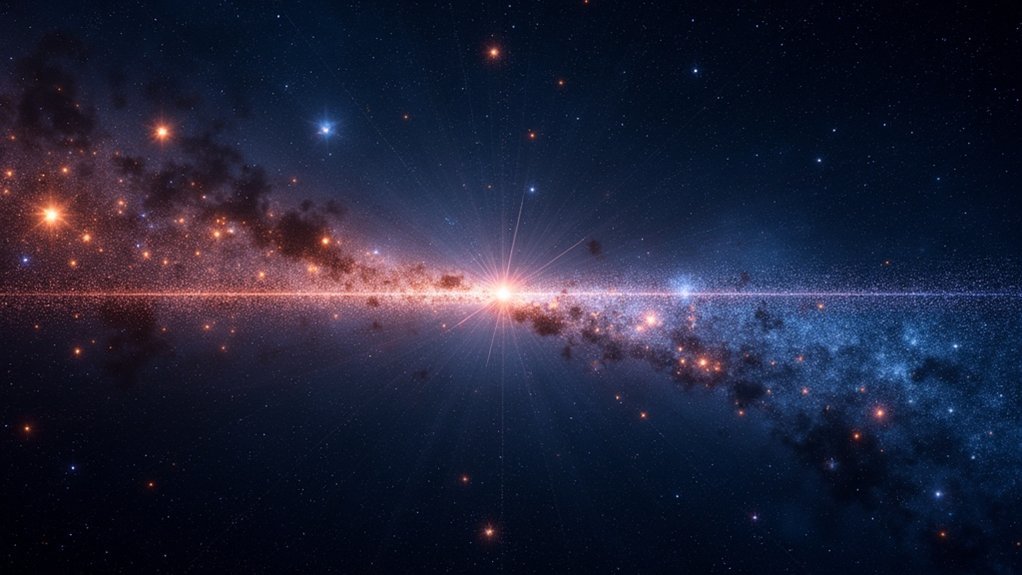
When astronomers survey the night sky, they discover that approximately 90% of all visible stars belong to what we call the main sequence—a distinctive diagonal band stretching across the Hertzsprung-Russell diagram.
This dominant group runs from hot, luminous stars in the upper left to cool, dim stars in the lower right of the HR diagram. Each star along this sequence burns hydrogen into helium, which constitutes the longest phase of stellar evolution.
Our Sun, a G2 star with a surface temperature of 5,400 Kelvin, sits comfortably in the middle of this band.
The main sequence follows a strict mass-luminosity relationship (L ∝ M^3.5), meaning more massive stars shine dramatically brighter than their smaller counterparts.
A star’s mass determines its destiny—even a modest increase creates exponentially greater brilliance across the cosmic stage.
Stars typically spend about 10 billion years in this stable state before evolving off the main sequence.
Giants and Supergiants: Understanding Stellar Evolution
When you examine the upper right region of the Hertzsprung-Russell diagram, you’ll find giants and supergiants that have expanded dramatically after exhausting their core hydrogen fuel.
These evolved stars maintain high luminosities despite cooler surface temperatures, with supergiants shining tens of thousands of times brighter than our Sun while spanning distances up to 1,500 times its radius.
The inverse relationship between temperature and size reflects fundamental stellar physics, where post-main sequence stars must expand to radiate their energy output across a larger surface area.
Post-Main Sequence Expansion
Stars undergo dramatic transformations once they’ve depleted the hydrogen fuel in their cores. They leave the main sequence on the Hertzsprung-Russell diagram and expand remarkably, becoming red giants or supergiants with cooler surface temperatures but considerably higher luminosities.
You’ll find these evolved stars in the upper right section of the diagram, where their massive size compensates for lower temperatures. Red giants typically reach 3,000-5,000 K with radii hundreds of times larger than our Sun, while supergiants can achieve luminosities exceeding 100,000 solar luminosities with temperatures ranging from 3,500-20,000 K.
This post-main sequence evolution varies by stellar mass—massive stars progress through these phases more rapidly than smaller stars like our Sun, which might take billions of years to begin expansion.
Luminosity Vs Temperature
Although surface temperature decreases as stars evolve beyond the main sequence, their overall luminosity dramatically increases—creating the distinctive pattern of giants and supergiants on the H-R diagram.
You’ll find these evolved stars in the upper right region, where they shine thousands of times brighter than the Sun despite cooler surface temperatures of 3,500-5,000 Kelvin. This apparent contradiction reveals a vital aspect of stellar evolution: as stars exhaust their hydrogen fuel and begin burning heavier elements, they expand enormously.
A star like Betelgeuse demonstrates this principle perfectly—its cooler spectral type doesn’t diminish its brightness. Instead, its vastly increased size (up to 1,500 times the Sun’s radius for supergiants) compensates for the lower temperature.
The Hertzsprung-Russell diagram consequently maps not just static star properties but their evolutionary journey off the main sequence.
White Dwarfs and Stellar Remnants: The Afterlife of Stars
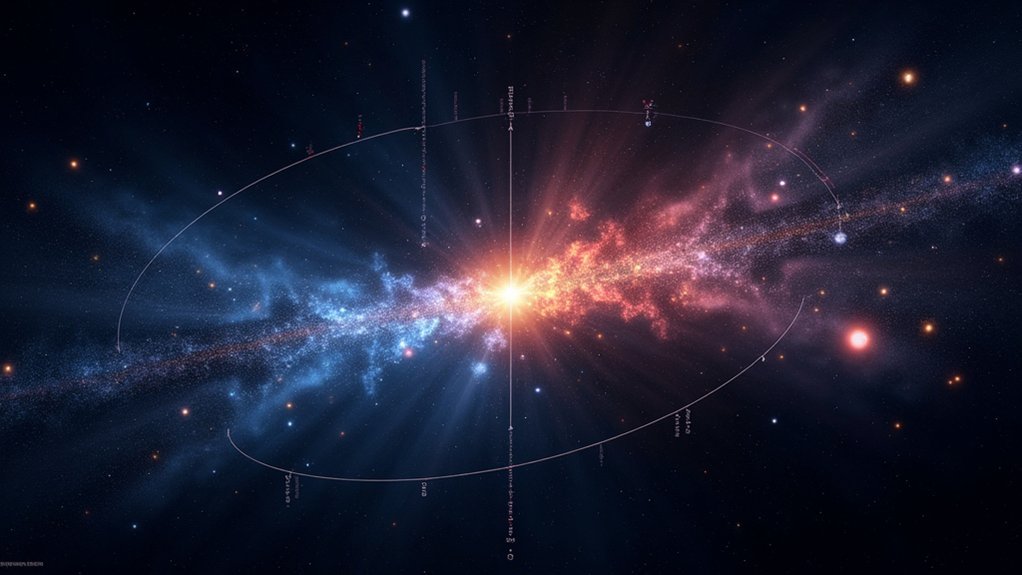
In the lower left corner of the H-R diagram, you’ll find white dwarfs—compressed stellar cores about the size of Earth but containing the mass of our Sun.
You can track their cooling evolution pathway as they gradually fade from hot, dim objects into theoretical black dwarfs over trillions of years.
The unusual mass-radius relationship of white dwarfs reveals that heavier white dwarfs are actually smaller in size, a counterintuitive property resulting from electron degeneracy pressure that prevents further gravitational collapse.
Compressed Stellar Cores
After exhausting their nuclear fuel, low to intermediate mass stars enter their final, fascinating phase of existence as white dwarfs. You’ll find these stellar corpses in the lower-left region of the Hertzsprung-Russell diagram, where they exhibit extreme temperatures but surprisingly low luminosity.
| Stellar Remnant | Mass Range | Formation | Density |
|---|---|---|---|
| White Dwarf | 0.1-1.4 Mʘ | Nuclear fusion ends | 10⁶ g/cm³ |
| Neutron Star | 1.4-3 Mʘ | Supernova | 10¹⁵ g/cm³ |
| Black Hole | >3 Mʘ | Core collapse | Infinite |
| Black Dwarf | ≤1.4 Mʘ | White dwarf cooling | 10⁶ g/cm³ |
White dwarfs undergo an incredibly slow cooling rate, with theoretical lifespans exceeding 10 billion years. More massive stars follow different evolutionary paths, producing denser remnants—neutron stars or black holes—through spectacular supernova explosions.
Cooling Evolution Pathway
White dwarfs commence a remarkable cooling journey that you’ll find uniquely plotted on the H-R diagram. These stellar remnants occupy the lower left section, revealing their high temperatures but surprisingly low luminosities due to their compact size.
When you track a white dwarf’s cooling pathway on the Hertzsprung-Russell diagram, you’ll observe a gradual descent as they lose both heat and brightness. Starting at temperatures exceeding 100,000 K, they’ll slowly cool for billions of years, moving downward on their evolutionary track.
This cooling sequence isn’t just fascinating—it’s scientifically valuable. By analyzing where white dwarfs sit along this pathway, you can determine the ages of star clusters with remarkable precision.
The cooling rates of these stellar corpses provide essential time markers in our understanding of stellar evolution.
Mass-Radius Relationship
Three fundamental properties define white dwarfs on the H-R diagram: their unusual mass-radius relationship sets them apart from main sequence stars. When you examine these stellar remnants, you’ll find that as mass increases, radius decreases—contrary to main sequence behavior. This inverse relationship occurs because electron degeneracy pressure counteracts gravitational collapse.
| Mass (Solar) | Radius (Solar) | Radius (Earth) |
|---|---|---|
| 0.5 | 0.02 | 2.2 |
| 0.7 | 0.015 | 1.6 |
| 1.0 | 0.01 | 1.1 |
| 1.2 | 0.007 | 0.8 |
| 1.4 | 0.004 | 0.4 |
The Chandrasekhar limit (~1.4 solar masses) represents the maximum possible white dwarf mass. Beyond this limit, electron degeneracy pressure cannot resist collapse, and the star transforms into a neutron star or black hole instead.
Reading Stellar Ages Across the Diagram
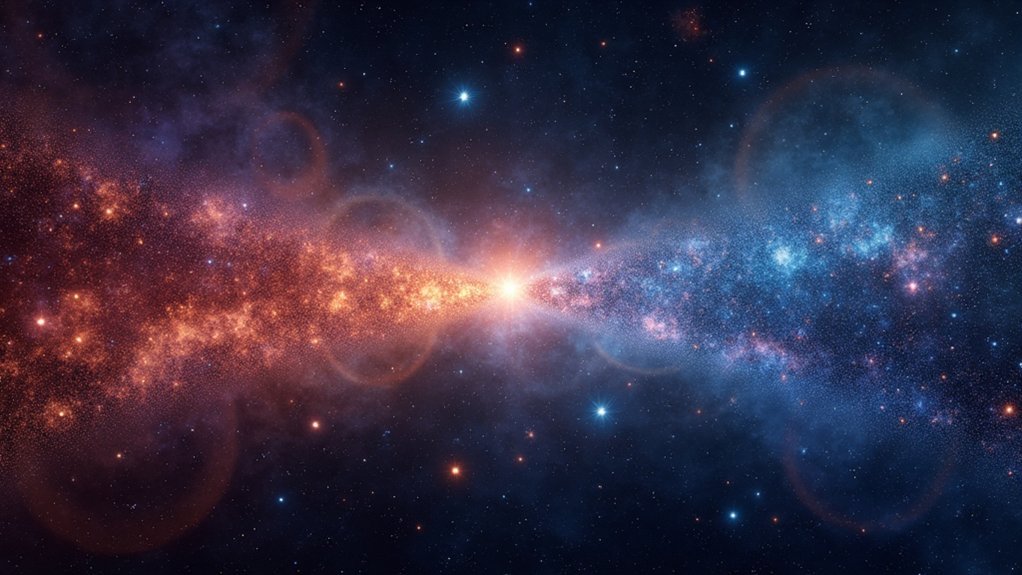
The Hertzsprung-Russell diagram serves as a powerful tool for astronomers to decode stellar ages by examining where stars fall on this cosmic map.
You’ll find that stars spend roughly 90% of their lives along the main sequence, with upper sequence stars evolving faster than their lower counterparts.
When you observe stars that have moved off the main sequence into red giant or supergiant territories, you’re seeing evidence they’ve exhausted their hydrogen fuel, indicating later life stages.
In star clusters, the turn-off point where stars begin leaving the main sequence marks the cluster’s age.
White dwarfs present in clusters offer additional age clues, as they represent the remnants of completed stellar lifecycles.
Star Clusters and Population Studies in the H-R Diagram
When astronomers plot hundreds or thousands of stars from the same cluster onto the H-R diagram, fascinating patterns emerge that reveal the cluster’s life story.
You’ll notice globular and open star clusters display distinctive signatures on the diagram. Globular clusters exhibit well-defined main sequence patterns with clear turn-off points that function as cosmic clocks, indicating the cluster’s age.
By comparing stars’ apparent magnitude with their absolute magnitudes derived from their H-R diagram positions, you can estimate cluster distances with remarkable precision.
The diagram also helps you identify special stellar populations, including variable stars located in the instability strip.
Through comparative analysis of different clusters, you can determine population characteristics, composition differences, and evolutionary stages as stars distribute across various luminosity and temperature ranges—effectively reading the demographic history of stellar communities.
The Mass-Luminosity Connection: What Your Position Reveals
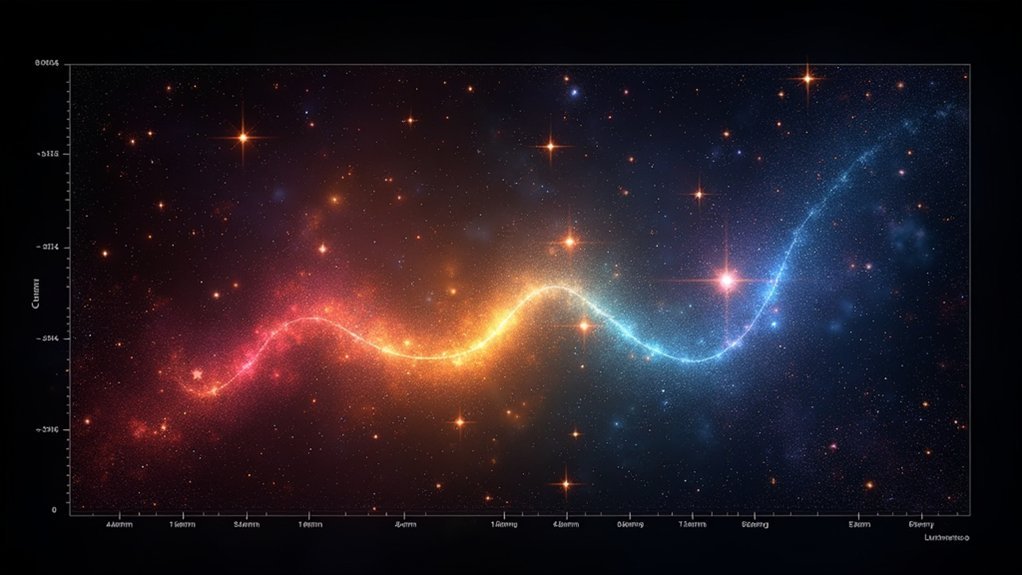
Why does a star’s position on the main sequence matter so much? It reveals the star’s fundamental properties through the mass-luminosity relation. When you locate a star on the Hertzsprung-Russell diagram, you’re uncovering its life story.
| Star Type | Mass (Sun=1) | Luminosity (Sun=1) | Main Sequence Lifetime |
|---|---|---|---|
| O stars | 20+ | 100,000+ | ~1-10 million years |
| B stars | 3-20 | 100-10,000 | ~10-100 million years |
| G stars | 0.8-1.2 | 0.6-1.5 | ~10 billion years |
| M stars | 0.1-0.5 | 0.001-0.1 | 100+ billion years |
The L ∝ M^3.5 relationship explains why massive stars burn so brilliantly yet briefly. A 10-solar-mass star shines 10,000 times brighter than our Sun but exhausts its fuel dramatically faster, accelerating its stellar evolution off the main sequence.
Modern Applications: How Astronomers Use H-R Diagrams Today
While classical in origin, H-R diagrams remain essential tools in modern astronomy’s arsenal. You’ll find astronomers leveraging these plots to classify stars based on their temperature and luminosity patterns, revealing significant details about their evolutionary stages.
When you examine star clusters through an H-R diagram lens, you can determine their distances by comparing apparent and absolute magnitudes. ESA’s Gaia mission has revolutionized this application, disclosing unprecedented detail in white dwarf distributions and diverse stellar populations.
The mass-luminosity relation—directly visible on the diagram—helps you understand why stars with different masses behave differently. This relationship underpins models of stellar stability and lifecycle predictions.
Frequently Asked Questions
What Does the Hertzsprung-Russell Diagram Tell Us?
The Hertzsprung-Russell diagram shows you how stars relate by temperature and luminosity. You’ll see main sequence stars, red giants, and white dwarfs, helping you understand stellar evolution, masses, and lifespans.
How Can a Hertzsprung-Russell Diagram Be Used to Show the Evolution of a Star?
You can track a star’s evolution on the H-R diagram as it moves from the main sequence to giant phases, showing how its temperature and luminosity change throughout its lifetime.
What Does the Hertzsprung-Russell Diagram Tell Us About the Star Betelgeuse?
You’ll find Betelgeuse in the upper right region of the H-R diagram, showing it’s a red giant with high luminosity (50,000× Sun’s) but low temperature (3,500K), indicating it’s burning helium and approaching death.
What Does an H-R Diagram Tell Us About Star Clusters?
You’ll see a star cluster’s HR diagram reveals its age through the main sequence turn-off point. It’ll show stellar evolution stages, population characteristics, and formation history as stars with similar distances are directly comparable.
In Summary
You’ve now seen how the Hertzsprung-Russell diagram serves as astronomy’s most powerful visual tool. It’s not just a pretty plot—it’s your roadmap to understanding stellar evolution, mass relationships, and cosmic timeframes. When you examine an H-R diagram, you’re witnessing billions of years of stellar lives compressed into a single image. Stars tell their complete stories here, from fiery birth to dramatic death.




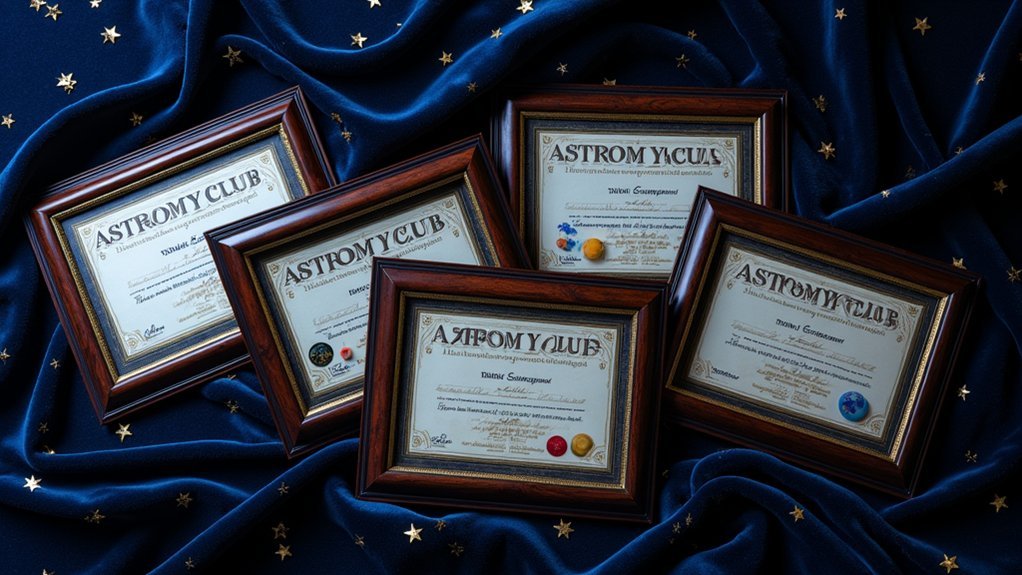
Leave a Reply